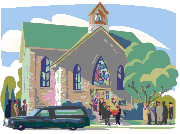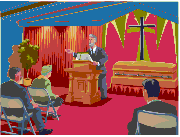|
Pallbearers - Funeral Etiquette
Pallbearers is the modern name for those individuals who carry a casket to the grave. The name and ceremonial function is far older. In ancient Rome, when a man died, his cloak, or "pallium," was spread over his body or coffin as it was carried from the home to the cemetery. A group of men would bear the body on their shoulders. By the time of the Middle Ages in Europe, the "pallium" had become a "pall" that was rectangular and was used to cover the coffin especially as it lay in a Christian church. By this time, one group of men would bear the body and a second group of men would march beside them in the procession, holding the hem of the pall to keep it from blowing off in the wind. The pall was loaned by the church or guild for member funerals, and it was very decorative and might even have an elaborate coat of arms. The pall is still used in certain religious denominations to cover the casket while in the church. In military or State funerals, the national flag serves as a pall over the casket.
At some point, the second group of bearers disappeared from the ceremony but the slightly incorrect name remains.
Bearers are usually selected by the family and loved ones. The main bearers are usually friends, relatives, grandsons, church members or business associates.
The Honorary bearers could be selected business associates, church members and/or social organization members. In absence of these selected people, it is not unheard of to select family members and friends. This is an emotional time for all. Support and kindness is the important issue, definitely not the time for squabbling and one upmanship! Also, it would be nice to send an individual thank you note with a personal message to each bearer. How do I select honorary pallbearers and what do they have to do? The role of the bearers is sometimes an honorary one since some services are planned without the presence of a coffin. The family member who is organizing the funeral will usualy consult with the rest of the family and friends and ask six or eight people who were close to the deceased to be honorary bearers. Some schools of etiquette believe a family member should never be a pallbearer, but recently one our readers sent us a very emotional letter because someone had told him it was very bad etiquette for a family member to be a pallbearer. The poor man had just lost both his parents and all he wanted to do was carry his mother on her final journey because she had carried him for 9 months and gave him life. How sad to let 'etiquette' dictate what is right or wrong in a case such as this!
Honorary bearers do not serve at a memorial service, they only serve at funerals.
In the Jewish tradition, the casket may be covered with a specially prepared cloth, called a pall, and is borne from the funeral service to the gravesite by family or friends (pallbearers) selected by the mourners. At a Jewish funeral, pallbearers customarily stop seven times while carrying the casket to the grave. The mourners, family and friends follow the casket as a mark of respect.
Military funerals - the casket is generally covered with a flag. The flag etiquette is very strict and formal: The canton should be draped over the upper left corner of the casket. The flag should be removed before the casket is lowered into the grave or, at a crematorium, after the service. One should not refuse an invitation to be a bearer except in the case of illness or absence from the location in which the funeral is being held. Funeral Religious Customs
Can't find what you are looking for? Try our Google Search below:
We would love you to share your experiences and views on pallbearer etiquette in our Interactive Visitors Forum Pallbearers Your contribution if appropriate, may be published on our Rage Page. Back to our A to Z Guide
|



 For convenience the honorary pallbearers sit in the first two pews on the left, and after the service leave the church two by two and walk in front of the coffin.
For convenience the honorary pallbearers sit in the first two pews on the left, and after the service leave the church two by two and walk in front of the coffin.
